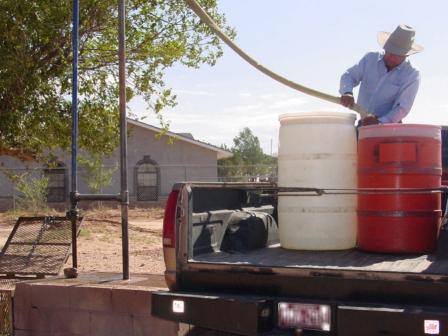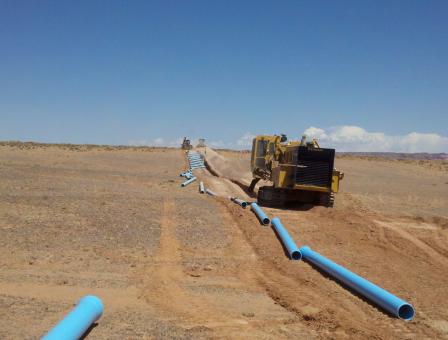Providing Safe Drinking Water in Areas with Abandoned Uranium Mines
 NNEPA estimates that up to 30% of the population must haul water because they are not served by piped water systems.
NNEPA estimates that up to 30% of the population must haul water because they are not served by piped water systems. IHS and HUD contributed $4.7M to construct the Monument Valley waterline extension to serve 128 homes without piped water.
IHS and HUD contributed $4.7M to construct the Monument Valley waterline extension to serve 128 homes without piped water.
Safe Drinking Water
The federal government and the Navajo Nation are working together to increase access to safe drinking water by extending public water systems to serve homes without piped water, and by making safe drinking water more accessible for residents who continue to haul water.
Since 2008, IHS, EPA, and HUD contributed $58M to provide access to safe drinking water for 3,013 homes in the abandoned uranium mine regions. NTUA and IHS also added new regulated water hauling points, and upgraded three existing watering points.
Background
The Navajo Nation estimates that up to 30% of the population (approximately 54,000 people) do not have piped water to their homes. These residents haul water either from safe watering points or from unregulated sources, such as livestock wells and springs. The number of unregulated water sources is estimated to be in the low thousands.
NNEPA policy prohibits the use of unregulated sources for human consumption because these sources are not routinely tested and regulated in accordance with the Safe Drinking Water Act. These unregulated sources are susceptible to bacterial contamination, including fecal coliforms. Some of these unregulated water sources exceed drinking water standards for uranium and other chemicals. Nevertheless, human consumption of unregulated water is reportedly widespread due to a lack of public water systems in the more remote and sparsely populated regions of the Navajo Nation. The use of unregulated water sources is the greatest public health risk associated with drinking water for the Navajo Nation.
The rural terrain and sparse population in many areas pose unique challenges for traditional piped water solutions. IHS estimates that it will cost $200M to provide access to safe drinking water and basic sanitation to all Navajo homes. Therefore, the Navajo Nation and the federal agencies have been working together to implement novel approaches to address this vitally important issue.
Unregulated Water Samples
From 2006-2010, NNEPA, EPA and the Centers for Disease Control (CDC) sampled 240 unregulated water sources, based on proximity to abandoned uranium mines and known uses. Most of these sources are used for livestock consumption and some are also used for human consumption. Twenty-nine of the sampled sources exceeded drinking water standards for radionuclides, including uranium. Signs are posted at these contaminated water sources warning individuals not to drink the water. With Chapter support, three of the contaminated wells are shut down.
- How to Safely Haul and Store Drinking Water
Only regulated water sources are safe to drink because they are routinely sampled and regulated in accordance with the Safe Drinking Water Act, according to NNEPA. For information about how to safely haul and store drinking water, see NNEPA’s safe water hauling guidelines Exit to inform residents how to properly haul and store drinking water.
